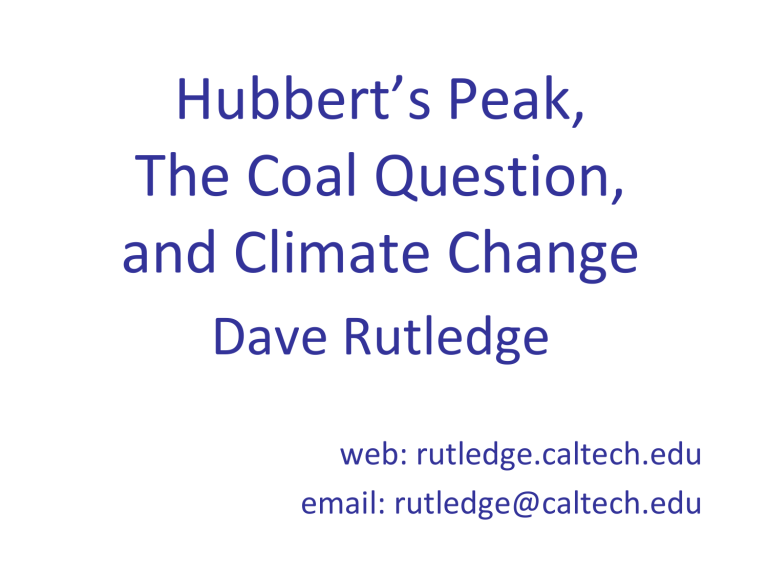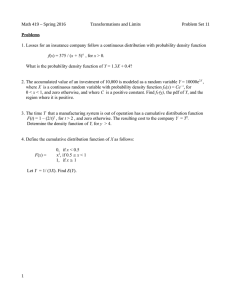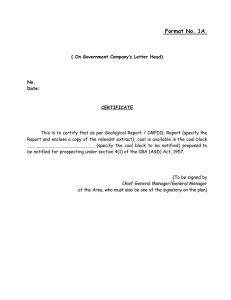Hubbert’s Peak, The Coal Question, and Climate Change Dave Rutledge

Hubbert’s Peak,
The Coal Question, and Climate Change
Dave Rutledge
web: rutledge.caltech.edu
email: rutledge@caltech.edu
The UN Panel on
Climate Change (IPCC)
• Released 4 th Assessment Report in 2007
• The IPCC works with scenarios
“… alternative images of how the future might unfold.”
• “… 40 SRES [Special Report on Emissions Scenarios] scenarios together encompass the current range of uncertainties…”
2
Oil Production in the IPCC Scenarios
• Gb = billions of barrels
• In some scenarios, production is rising in 2100
implied range is 10:1
• Dominates the uncertainty in climate simulations
the IPCC range for temperature sensitivity to CO
2 increases is 2.3:1
3
Goal is to Reduce the Uncertainty for
Fossil-Fuel Production to below the
Uncertainty for Temperature Sensitivity
• Historical study of the two major national fossilfuel resources with significant exhaustion
– US oil
Hubbert’s peak
– British coal
The Coal Question
• Other examples
– US whale oil
– Pennsylvania anthracite
• Projections for world oil, gas, and coal production
• Implications for alternatives to fossil fuels
• Simulations for CO
2 levels and temperatures
4
King Hubbert
• Geophysicist at the Shell lab in
Houston, Texas
• In 1956, he wrote a paper with predictions for the peak year of US oil production
5
Hubbert’s Peak
“Optimistic” ultimate
1970
Hubbert’s ultimate
• BBLS = barrels
• CUMULATIVE PRODUCTION = past production
• ULTIMATE = cumulative production plus future production
6
US Oil Production
7
Cumulative Plot for US Oil
• Ultimate production means total production, past and future
• Projection for ultimate is 225Gb (104% of reserves + cumulative)
• Reserves are resources that could be economically produced
• USGS 1995/MMS 2006 assessment + cumulative is 385Gb (71% higher)
• USGS = US Geological Survey, MMS = Mineral Management Service
8
Rate Plot for US Oil
• Rate plots were developed by Kenneth Deffeyes
• Growth Rate = annual production/cumulative production
• Dashed curve is the previous fitted normal
9
Historical Fits for US Oil Ultimate
• Range for fits for ultimate from 1956 on is 1.1:1
• Small circles are private estimates, large circles are government
• Private average is 240Gb, government average is 430Gb
10
Are the Government Assessments too High?
“When USGS workers tried to estimate resources, they acted, well, like bureaucrats. Whenever a judgment call was made about choosing a statistical method, the USGS almost invariably tended to pick the one that gave the higher estimate.”
Kenneth Deffeyes
Professor of Geology, emeritus,
Princeton University
Deffeyes’ Law of Bureaucratic Resource Estimates
11
British Coal
Photo by
The Coal Question (1865)
Stanley Jevons
13
UK Coal Production
• Mt = millions of metric tons
• Production is now 20 times less than the peak
14
Rate Plot for UK Coal
• Rate plot does not curve, fit to a logistic rather than normal
15
Historical Fits for UK Coal Ultimate
• Range in fits for ultimate from 1905 on is 1.2:1
• Produced 18% of 1905 Royal Commission reserves + cumulative
• Criteria were too optimistic ― 1ft seams, 4,000ft depth (Deffeyes’ law)
16
US Whale Oil Production
• Used for lighting and lubrication
• Whales did not become scarce in the 19 th century
• Competition in lighting from kerosene from coal and oil
• Competition from lubricants from petroleum products
17
Rate Plot for US Whale Oil
18
Historical Fits for US Whale Oil Ultimate
• Range for fits for ultimate from 1840 on is 1.2:1
19
American Coal
Photo by
US Coal Production
21
Pennsylvania Anthracite
• Burns without smoke — useful for home heating
• Current production is 60 times less than the peak
22
Rate Plot for PA Anthracite
23
Historical Fits for PA Anthracite
• Range for fits for ultimate from 1921 on is 1.2:1
• Produced 42% of 1921 reserves + cumulative
24
Coal West of the Mississippi
• Projection for ultimate is 48Gt (30% of reserves + cumulative)
25
Coal East of the Mississippi
• Projection for ultimate is 83Gt (58% of reserves + cumulative)
26
Rate Plot for Canada
• Projection for the ultimate is 4Gt (47% of reserves + cumulative)
27
Reserves History for US Coal
• Paul Averitt responded to criticism from mining engineers by tightening reserve criteria — seams at least 28 inches thick, up to
1,000 feet deep, within 3/4 mile from a measurement, 50% recovery
• Violation of Deffeyes’ Law
28
Are US Coal Reserves Still Too High?
“Present estimates of coal reserves are based upon methods that have not been reviewed or revised since their inception in 1974 [when Paul
Averitt retired], and much of the input data were compiled in the early 1970’s. Recent programs to assess reserves in limited areas using updated methods indicate that only a small fraction of previously estimated reserves are actually minable reserves.”
National Academy of Sciences, 2007
29
Rate Plot for China
• Projection for ultimate is 112Gt (72% of reserves + cumulative)
30
Historical Fits for Chinese Coal Ultimate
• Reserves submitted to World Energy Council in 1989 and 1992 differ by 6:1
31
Production for Japan and South Korea
• Production is now 15 times less than the peak
• Produced 16% of the 1960 reserves + cumulative
• Range in the fits for the ultimate from 1960 on is 1.5:1
32
Rate Plot for Europe
• Includes Ukraine and Turkey, but not UK, France or Belgium
• Projection for ultimate is 120Gt (75% of reserves + cumulative)
• Bituminous reserves collapse for Germany — 23Gt to 183Mt
33
Production for France and Belgium
• Production is now 300 times less than the peak
• Produced 34% of the 1948 reserves + cumulative
• Range for fits in the ultimate since 1948 is 1.3:1
34
Rate Plot for South Asia
• Includes Middle East and Taiwan
• No projection for the ultimate, reserves + cumulative is 78Gt
• India recently shifted from reporting coal-in-place to recoverable coal
― 92Gt to 56Gt
35
Rate Plot for Russia
• Includes Mongolia and North Korea, and the FSU except the Ukraine
• Projection for the ultimate is 74Gt (34% of reserves + cumulative)
36
Rate Plot for Australia
• Includes New Zealand
• Australia has been the world’s largest exporter since 1984
• Projection for the ultimate is 58Gt (68% of reserves + cumulative)
37
Rate Plot for Africa
• Apartheid ended in 1990
• SASOL built two large coal-to-liquids plants in 1980 and 1982
• Projection for the ultimate is 22Gt (39% of reserves + cumulative)
38
Rate Plot for Latin America
• Includes Mexico
• No projection for the ultimate, reserves + cumulative is 19Gt
39
Projections for Ultimates
Region
Europe, with the UK, and France and Belgium
US and Canada
China, and Japan and South Korea
South Asia
Russia
Australia and New Zealand
Africa
Latin America, with Mexico
World
Projection, Gt
155
141
115
78
74
58
22
19
662
• Projection is 59% of World Energy Council reserves + cumulative
• Maximum in an IPCC scenario through 2100 is 3,400Gt
40
Where Does the IPCC Get Its Coal?
World Energy
Council survey
1992
Proved recoverable reserves, Gt
1,039
Additional recoverable reserves, Gt
702
1995
1998
2001
2004
1,032
984
984
909
680
3,368
409
449
2007 847 180
• The scenario report, SRES, references the 1995 and 1998 WEC surveys
• Proved recoverable reserves are declining because of the trends toward reporting recoverable coal and coal at working mines
• The IPCC chose to use Additional recoverable reserves and they also chose 1998 (3,368Gt), rather than 1995 (680Gt) — Additional recoverable reserves are now 20 times smaller than in 1998
41
Rate Plot for World Oil and Gas
• 7.33 barrels of oil = 1 metric ton, toe = metric tons of oil equivalent
• Projection for ultimate is 641Gtoe, 110% of BP reserves + cumulative
42
Historical fits for Oil, Gas, and Coal Ultimate
• Projection for ultimate is 1.0Ttoe, 85% of reserves + cumulative
• Range of fits for ultimate from 1992 on is 1.2:1
• Cumulative is 39% of the ultimate— percentage increases 1% per year
43
Alternatives for Oil
• 5-year world growth rate 2%/year
• Ethanol has a 1% share
– 5-year growth rate is 20%/year
these growth rates would give a 10% share by 2024
– 1% of world’s cultivated land is used for ethanol
• Other prospects?
Half of world oil is not used for transportation
44
Alternatives for Electricity
• 10-year world growth rate is 4% per year
• Hydroelectric has a 16% share
• Nuclear has a 14% share
• Wind has a 1% share
– 10-year growth rate is 29% per year — these growth rates would give a 10% share by 2017
– 1/3 of new US capacity in 2007
• Solar photovoltaic is ten years behind wind
– 10-year growth rate is 37% per year — these growth rates would give a 10% share by 2026
– Local generation
• Other prospects?
45
Photo: Schott Glass
Concentrating Solar Thermal
46
Nevada Solar One
Photo: Schott Glass
47
Concentrating Solar Thermal
• Capacity
354MW built from 1984 to 1990 in California
– 75MW in 2007
Nevada Solar One, PS10 in Spain
– 55MW in 2008
Kimberlina in California, Andasol 1 in Spain
• Andasol 1 plant has 8 hours of thermal storage
solar thermal plants with storage could provide both peak capacity and base production
• Construction takes one or two years
main materials are glass and steel, could be built on any conceivable scale
• Suitable only for regions without clouds, but could get continental reach through DC transmission lines
loss is
4% per 1,000km, plus 0.6% switch loss at each end
48
Comparing with the IPCC Scenarios
• Carbon coefficients for oil, gas, and coal from 4 th Assessment Report
• Projection for ultimate, 830GtC, is less than any of the IPCC scenarios
49
Simulated Carbon-Dioxide Levels
• Simulations with Tom Wigley’s MAGICC software, updated for the 4 th
Assessment Report into account (version 5.3) — with Tom’s revised
WRE stabilization scenarios for other greenhouse gases
• Jim Hansen advocates reducing coal consumption to reach 350-ppmv
— sensitivity of peak to current coal production is 0.1ppmv/Gt
50
Simulated Temperature Rise
• IPCC recommended temperature sensitivity, 3
C/2
CO
2
• Peak is 2
C above the 1850-1900 average
European Union policy is that “Global annual mean surface temperature increase should not exceed 2°C above pre-industrial levels”
51
Hypothesis: Curve-fits to cumulative production can give stable estimates for world ultimates
• Major national fossil-fuel resources
– US oil (1970 peak)
1.1:1 range since 1956
– British coal (1913 peak)
1.2:1 range since 1905
• Other examples
– US whale oil (1841 peak)
1.2:1 range since 1840
– Pennsylvania anthracite (1917 peak)
1.2:1 range since 1921
– Japan and South Korea coal (1966 peak)
1.5:1 range since 1960
– France and Belgium coal (1957 peak)
1.3:1 range since 1948
• Projections for world ultimates
1.2:1 range since 1992
– Oil, gas, and coal is 1.0Ttoe (85% of reserves + cumulative)
– Coal is 662Gt (59% of reserves + cumulative)
52
Many Thanks for Help
• Sandro Schmidt at the BGR (the German Resources Agency)
• Morgan Granger, Melissa Chan, Ed Rubin and Jay Apt at Carnegie-Mellon
• Charlie Kennel at the University of California at San Diego
• Kevin Bowman and Dimitri Antsos at the Jet Propulsion Laboratory
• John Rutledge at Freese and Nichols, Inc. in Fort Worth, Texas
• Kyle Saunders, Euan Mearns, and Dave Summers at The Oil Drum
• Andrew Ferguson at Optimum Population Trust
• Steve Mohr at the University of Newcastle, New South Wales
• Randy Udall at the Community Office for Resource Efficiency in Colorado
• Jim Murray at the University of Washington
• Many Caltech colleagues, but particularly Bill Bridges, Paul Dimotakis,
David Goodstein, Melany Hunt, Kent Potter, Nadia Lapusta, John Ledyard,
Carver Mead, Tapio Schneider, John Seinfeld, and Tom Tombrello
Special thanks to Sandy Garstang and Shady Peyvan in the Caltech
Library, Tony Diaz in the Caltech Geology Library, and Dale Yee in the
Caltech Engineering Division for their perseverance and ingenuity in locating historical coal production and reserves records
53




